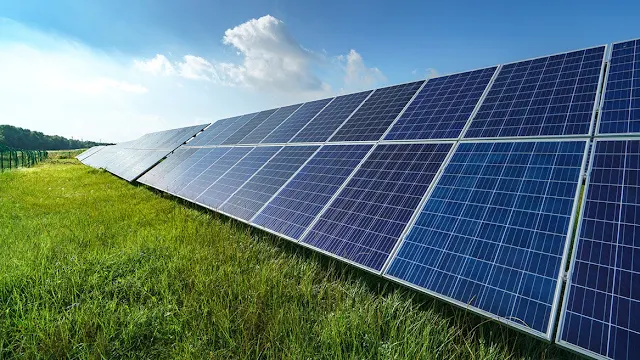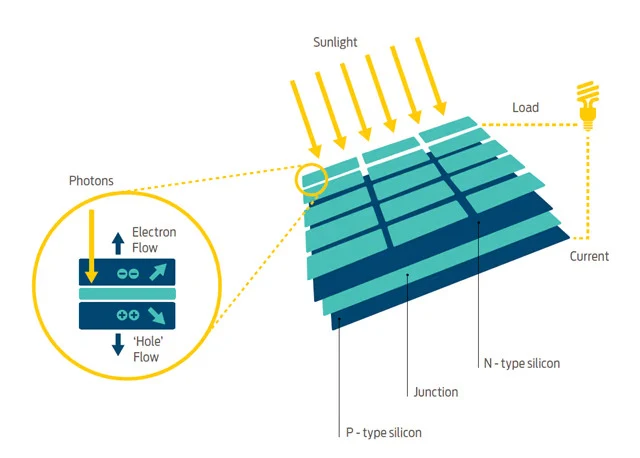Sun light is actually a mixture of light and heat, and the light itself is a mixture of different frequencies of electromagnetic radiation, including invisible ultraviolet (the sunlight that gives you sunburn) and infrared (the invisible light you feel as radiated heat if you stand near something like a camp fire or barbecue). The great thing about solar energy is that it's plentiful and free. In theory, every horizontal square meter of Earth receives about 1kW of power from the Sun (assuming overhead Sun at midday and a cloudless sky): that's 1000 joules of energy every single second, which adds up to a huge amount over the course of a (sunny) day.
Energy from the Sun is the most abundant and absolutely freely available energy on planet earth. In order to utilize this energy we need help from the second most abundant element on earth, sand. The sand has to be converted to 99.999% pure silicon crystals to use in solar cells. To achieve this, the sand has to go through a complex purification process as shown. The raw silicon gets converted into a gaseous silicon compound form. This is then mixed with hydrogen to get highly purified polycrystalline silicon. These silicon ingots are reshaped, and converted into very thin slices called silicon wafers. The silicon wafer is the heart of a photovoltaic cell.
What are solar cells?
A solar cell is an electronic device that catches sunlight and turns it directly into electricity. It's about the size of an adult's palm, octagonal in shape, and colored bluish black. Solar cells are often bundled together to make larger units called solar modules, themselves coupled into even bigger units known as solar panels (the black- or blue-tinted slabs you see on people's homes, typically with several hundred individual solar cells per roof) or chopped into chips (to provide power for small gadgets like pocket calculators and digital watches).
What is solar cells made up of?
A solar cell is made of two types of semiconductors, called p-type and n-type silicon. The p-type silicon is produced by adding atoms such as boron or gallium that have one less electron in their outer energy level than does silicon. Because boron has one less electron than is required to form the bonds with the surrounding silicon atoms, an electron vacancy or “hole” is created.
The n-type silicon is made by including atoms that have one more electron in their outer level than does silicon, such as phosphorus. Phosphorus has five electrons in its outer energy level, not four. It bonds with its silicon neighbor atoms, but one electron is not involved in bonding. Instead, it is free to move inside the silicon structure.
A solar cell consists of a layer of p-type silicon placed next to a layer of n-type silicon. In the n-type layer, there is an excess of electrons, and in the p-type layer, there is an excess of positively charged holes (which are vacancies due to the lack of valence electrons). Near the junction of the two layers, the electrons on one side of the junction (n-type layer) move into the holes on the other side of the junction (p-type layer). This creates an area around the junction, called the depletion zone, in which the electrons fill the holes.
How Solar Cells Work?
It generates electricity by using sunlight to make electrons hop across the junction between the different flavors of silicon:
- When sunlight shines on the cell, photons (light particles) bombard the upper surface.
- The photons carry their energy down through the cell.
- The photons give up their energy to electrons in the lower, p-type layer.
- The electrons use this energy to jump across the barrier into the upper, n-type layer and escape out into the circuit.
- Flowing around the circuit, the electrons make the bulb light up.
Solar Energy Pros and Cons
Advantages of Solar Energy
- Lowers your Electricity Bills
- Environmentally Friendly
- Moves us Closer Towards Energy Independence
- Sustainable
- Low Maintenance
- Benefits the Electricity Grid
Disadvantages of Solar Energy
- Expensive Initial Investment
- It Won’t Work at Night
- Limited Energy Storage
- Space Constraints
- Isn’t 100% Pollution-Free
- Depends on Location
Types of Solar Power Systems:
On-Grid Solar System:
Off-grid Solar Power System:
Hybrid Solar Power System
Frequently Asked Questions: Solar Cells
Question No. 1: Can solar panels power a house?
Question No. 2: Why solar energy is good?
Question No. 3: Will solar panels save me money?
More From Tech You Might Like:
Fingerprint Scanners - How It Works
VPN - How It Works
QR Code - How It Works
Torrent - How It Works


